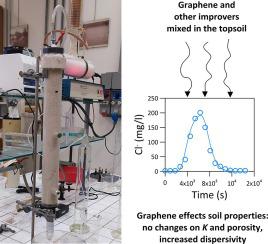Journal of Hydrology ( IF 5.9 ) Pub Date : 2022-07-29 , DOI: 10.1016/j.jhydrol.2022.128256 Luigi Alessandrino , Anna Laura Eusebi , Vassilis Aschonitis , Micòl Mastrocicco , Nicolò Colombani

|
In this study, for the first time, the changes in relevant hydraulic parameters (e.g., hydraulic conductivity, effective porosity, and dispersivity) induced by the introduction of graphene in a calcareous sandy soil and a siliciclastic riverine soil were monitored and modelled via leaching column experiments. Column experiments were also run with traditional soil improvers (compost, biochar, and zeolite) to compare the changes induced by graphene versus well-studied soil improvers. Constant pressure head tests were used to calculate the hydraulic conductivity of each column, while leaching experiments were run to estimate porosity and specific retention, and for each treatment three replicates were done. Columns were then run in saturated conditions via a low flow peristaltic pump and monitored for electrical conductivity, temperature, and chloride. CXTFIT 2.0 was employed to inversely model the column experiments and retrieve parameters like effective porosity, longitudinal dispersivity, bulk thermal diffusivity, and thermal retardation factor. Results highlighted small changes of hydraulic conductivity, porosity, and effective porosity induced by graphene addition (as well as by the other soil improvers) for both soils. A marked increase (nearly 20 %) of specific retention values was instead recorded in the amended columns with respect to control ones. Chloride breakthrough curves modelling showed that graphene doubled dispersivity in the calcareous sandy soil (5.82 ± 1.4 cm) compared to the control (2.6 ± 0.29 cm), while it halved dispersivity in the siliciclastic riverine soil (0.31 ± 0.05 cm) with respect to the control (0.65 ± 0.06 cm). Thermal retardation factors were decreased by graphene by approximately 20 % for both soils. The model fitting via TDS (derived from the electrical conductivity monitoring) produced unreliable dispersivity values in most of the experiments due to the nonconservative nature of this parameter compared to chloride. The results highlight that graphene affected dispersivity but did not significantly alter other physical parameters relevant for solutes transport in sandy soils in comparison to classical improvers, thus future studies should focus on the graphene’s effects on nutrients and agrochemicals leaching in unsaturated flow conditions.
中文翻译:

添加石墨烯和经典土壤改良剂引起的沙土水力特性变化
在这项研究中,首次通过浸出柱监测并模拟了石墨烯在钙质沙土和硅质碎屑河流土壤中引入石墨烯引起的相关水力参数(例如水力传导率、有效孔隙率和分散性)的变化。实验。还使用传统的土壤改良剂(堆肥、生物炭和沸石)进行了柱实验,以比较石墨烯与经过充分研究的土壤改良剂引起的变化。恒压水头测试用于计算每根柱的水力传导率,同时进行浸出实验以估计孔隙率和特定保留,并且对于每个处理进行三个重复。然后通过低流量蠕动泵在饱和条件下运行色谱柱并监测电导率、温度、和氯化物。使用 CXTFIT 2.0 对色谱柱实验进行逆向建模,并检索有效孔隙率、纵向弥散率、体积热扩散率和热延迟因子等参数。结果突出显示了两种土壤中石墨烯添加(以及其他土壤改良剂)引起的导水率、孔隙率和有效孔隙率的微小变化。与对照相比,特定保留值的显着增加(接近 20%)被记录在修改后的列中。氯化物突破曲线模型表明,与对照(2.6±0.29 cm)相比,石墨烯在钙质沙土(5.82 ± 1.4 cm)中的分散性增加了一倍,而在硅质碎屑河流土壤中的分散性(0.31 ± 0.05 cm)减半。控制(0.65 ± 0.06 厘米)。石墨烯使两种土壤的热阻滞系数降低了约 20%。由于与氯化物相比该参数的非保守性质,通过 TDS(源自电导率监测)的模型拟合在大多数实验中产生了不可靠的分散性值。结果表明,与经典改良剂相比,石墨烯影响分散性,但并未显着改变与沙质土壤中溶质迁移相关的其他物理参数,因此未来的研究应关注石墨烯对非饱和流动条件下养分和农用化学品浸出的影响。由于与氯化物相比该参数的非保守性质,通过 TDS(源自电导率监测)的模型拟合在大多数实验中产生了不可靠的分散性值。结果表明,与经典改良剂相比,石墨烯影响分散性,但并未显着改变与沙质土壤中溶质迁移相关的其他物理参数,因此未来的研究应关注石墨烯对非饱和流动条件下养分和农用化学品浸出的影响。由于与氯化物相比该参数的非保守性质,通过 TDS(源自电导率监测)的模型拟合在大多数实验中产生了不可靠的分散性值。结果表明,与经典改良剂相比,石墨烯影响分散性,但并未显着改变与沙质土壤中溶质迁移相关的其他物理参数,因此未来的研究应关注石墨烯对非饱和流动条件下养分和农用化学品浸出的影响。











































 京公网安备 11010802027423号
京公网安备 11010802027423号